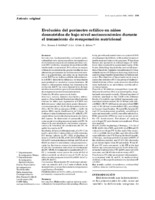Please use this identifier to cite or link to this item:
http://sgc.anlis.gob.ar/handle/123456789/168| Title: | Evolución del perímetro cefálico en niños desnutridos de bajo nivel socioeconómico durante el tratamiento de recuperación nutricional | Authors: | Gotthelf, Susana J. Jubany, Lilian L. |
Keywords: | Trastornos Nutricionales;Cefalometría;Recuperación Nutricional;Factores Socioeconómicos;Pediatría | Issue Date: | 2002 | Description: | Introducción. La desnutrición y el medio sociocultural adverso ejercen un efecto devastador en el crecimiento corporal y el sistema nervioso central (SNC) del niño, impactando en el desarrollo intelectual y conductual. Si lo afecta en etapas críticas de su crecimiento, puede resultar en una alteración permanente de las funciones del cerebro y su plasticidad, así como en su inserción social. El PC es un índice confiable del crecimiento del SNC durante la infancia y es importante para predecir su posterior comportamiento. El objetivo del presente trabajo fue determinar la evolución del PC de niños desnutridos de bajo nivel socioeconómico que recibieron tratamiento de recuperación nutricional ambulatoria. Población. 39 niños menores de 1 año. Material y métodos. Estudio descriptivo, retrospectivo y longitudinal. Se estudiaron las historias clínicas de niños que ingresaron al CNIN con déficit de peso/edad de distinto grado (desnutrición marasmática): 23,1% (9) desnutridos leves (DL); 66,7% (26) moderados (DM) y 10,3% (4) graves (DG) según clasificación de Gómez. Se evaluaron trimestralmente peso (P), talla (T) y PC según tablas nacionales hasta después de 2 años del ingreso. Se determinó el percentilo (Pc) 5 como punto de corte para compromiso del PC. Se observó la prevalencia de crecimiento compensador y la velocidad de crecimiento del PC. Se aplicó la prueba de X2. Resultados. Al inicio del tratamiento, el 11% (1) de los DL, el 42,3% (11) de los DM y el 100% (4) de los DG tenían valores de PC Introduction. Malnutrition and an adverse sociocultural environment have devastating effects on body growth and central nervous system (CNS) development in children, with marked impact on intellectual and behavioral outcomes. When these factors are operative in critical stages of childhood, they can result in a permanent injury of the brain, disturbing its plasticity and social insertion of the child. Cephalic circumference (CC) is a reliable index of CNS growth during childhood, and it is important for predicting its further outcome. The objective of the present study was to assess the outcome of CC in a group of malnourished children of low socio-economic level that were included in an ambulatory nutritional recovery program. Population. 39 children younger than 1 year old. Material & methods. This was a descriptive, longitudinal, retrospective study. Clinical registers of children admitted to the CNIN with different levels of weight for age deficit (marasmatic malnutrition) were reviewed: 23.1% (9) had mild deficit (MiD); 66.7% (26) had moderate deficit (MD) and 10.3% (4) had severe deficit (SD), according to Gomez’classification. Weight (W), height (H) and CC were measured quarterly, according to national standards, until 2 years after admission. Fifth percentile (5thP) was used as an end-point for CC involvement. Prevalence of catch-up growth and CC growth rate were analyzed. X2 test was applied. Results. At the beginning of therapy, 11% (1) of MiD, 42.3% (11) of MD, and 100% (4) of SD had CC values lower than 5thP. At the end of the study, 11% (1) of MiD, 8% (2) of MD, and 50% (2%) of SD were still below the 5thP. During the first 6 months of therapy, catch-up growth was seen in 68.8% of the children studied, and 87.2% (34) showed a growth rate higher than 90th percentile. When W, H and CC were compared, with 5thP at the last follow-up visit as an end-point, 74.4% of the children showed recovery of W; in 60%, recovery of H was seen, and 68.8% showed recovery of CC.Conclusions. CC is the most preserved parameter, as compared with W and H, in malnourished children, with a significant recovery incidence (P = 0.004). Fil: Gotthelf, Susana J. ANLIS Dr.C.G.Malbrán. Centro Nacional de Investigaciones Nutricionales Dr. Arturo Oñativia. Departamento de Investigación Clínica; Argentina. Fil: Jubany, Lilian L. ANLIS Dr.C.G.Malbrán. Centro Nacional de Investigaciones Nutricionales Dr. Arturo Oñativia. Departamento de Investigación Epidemiológica; Argentina. |
URI: | http://sgc.anlis.gob.ar/handle/123456789/168 www3.sap.org.ar/staticfiles/archivos/2002/arch02_3/204.pdf |
ISSN: | 1668-3501 | Rights: | info:eu-repo/semantics/openAccess |
| Appears in Collections: | snrd Publicaciones CeNIN |
Files in This Item:
| File | Description | Size | Format | |
|---|---|---|---|---|
| ArchivosArgentinosdePediatría,2002,100(3),204–209.pdf | 85.82 kB | Adobe PDF |  View/Open |
Page view(s)
392
checked on Jan 8, 2026
Download(s)
106
checked on Jan 8, 2026
Google ScholarTM
Check
Items in DSpace are protected by copyright, with all rights reserved, unless otherwise indicated.

